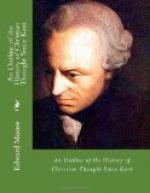Two things have been gained in this discussion. There is first the recognition that the canon is a growth. The holy book and the conception of its holiness, as well, were evolved. Christianity was not primarily a book-religion save in the sense that almost all Christians revered the Old Testament. Other writings than those which we esteem canonical were long used in churches. Some of those afterward canonical were not used in all the churches. In similar fashion we have learned that identical statements of faith were not current in the earliest churches. Nor was there one uniform system of organisation and government. There was a time concerning which we cannot accurately use the word Church. There were churches, very simple, worshipping communities. But the Church, as outward magnitude, as triumphant organisation, grew. So there were many creeds or, at least, informally accredited and current beginnings of doctrine. By and by there was a formally accepted creed. So there were first dearly loved memorials of Jesus and letters of apostolic men. Only by and by was there a New Testament. The first gain is the recognition of this state of things. The second follows. It is the recognition that, despite a sense in which this literature is unique, there is also a sense in which it is but a part of the whole body of early Christian literature. From the exact and exhaustive study of the early Christian literature as a whole, we are to expect a clearer understanding and a juster estimate of the canonical part of it. It is not easy to say to whom we have to ascribe the discovery and elaboration of these truths. The historians of dogma have done much for this body of opinion. The historians of Christian literature have perhaps done more. Students of institutions and of the canon law have had their share. Baur had more than an inkling of the true state of things. But by far the most conspicuous teacher of our generation, in two at least of these particular fields, has been Harnack. In his lifelong labour upon the sources of Christian history, he had come upon this question of the canon again and again. In his Lehrbuch der Dogmengeschichte, 1887-1890, 4te. Aufl., 1910, the view of the canon, which was given above, is absolutely fundamental.




